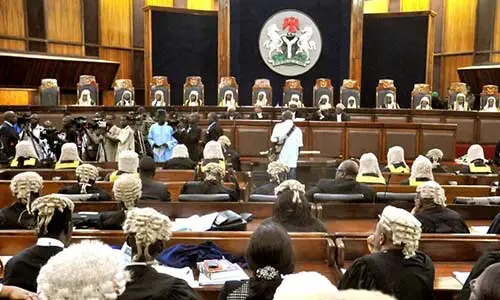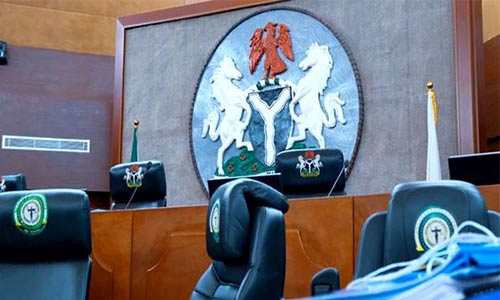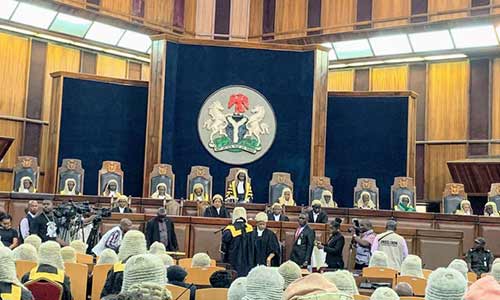SUPREME COURT JUDGEMENTS 20/06/2023
Burden Of Proof On Plaintiff To Prove Falsity Of Alleged Defamatory Statement

In the Supreme Court of Nigeria
Holden at Abuja
On Friday, the 3rd day of March, 2023
Before Their Lordships
Kudirat Motonmori Olatokunbo Kekere-Ekun
Mohammed Lawal Garba
Helen Moronkeji Ogunwumiju
Ibrahim Mohammed Saulawa
Adamu Jauro
Justices, Supreme Court
SC.442/2010
Between
DR JEREMIAH O. ABALAKA APPELLANT
And
1. PROF IBIRONKE AKINSETE
2. DR TIM MENAKAYA
3. AUWALU MOHAMMED FAROUK RESPONDENTS
(Lead Judgement delivered by Honourable Helen Moronkeji Ogunwumiju, JSC)
Facts
Sometime in March 2000, the 3rd Respondent was invited by the 1st and 2nd Respondent through the Federal Ministry of Health to a press conference, to educate others on his experience as one of those suffering from HIV/AIDS infection. During the press conference which was televised on NTA Newsline Program, the 3rd Respondent made comments about his experience with orthodox and traditional medical practitioners who claimed they had the cure to HIV/AIDS. He stated that he used the medication of the Appellant which the Appellant was touting as a cure for HIV/AIDS, but had not been cured. Thereafter, by a writ of summons dated 19th February, 2001, the Appellant instituted an action in defamation against the Respondents. The claim of the Appellant was that the Respondents made defamatory statements against him and his discovery at the press conference, and the report of the event in some print media. The Appellant itemised the offending words published in the print media as the report in Sunday Concord of 19th April, 2000 headlined “DR. ABALAKA’S AIDS CURE CLAIMS IS ONLY A RIP OFF. WHILE THE DOCTOR MAKES HIS MONEY, THE PATIENT DIES”; the report of Daily Monitor of 4th December, 2000 headlined “AIDS PATIENT PUNCTURES ABALAKA’S CLAIM” and the report of Daily Times of 7th December, 2000 headlined “UNAIDS SOLICITS INTERNATIONAL SOLIDARITY AGAINST AIDS”. He sought inter alia, jointly and severally against the Respondents, damages for libel and slander.
The Appellant testified, and called four witnesses. He also tendered the recorded telecast of the press conference, as Exhibit H. The 2nd and 3rd Respondent did not file any Statement of Defence, and none of the Respondents testified or called any witness. At the conclusion of trial, the trial court dismissed the Appellant’s claim. Dissatisfied, the Appellant appealed to the Court of Appeal. The Court of Appeal however, upheld the judgement of the trial court. Thereafter, the Appellant filed a further appeal before the Supreme Court.
Issue for Determination
The Apex Court adopted the issue for determination as couched by the 3rd Respondent’s counsel.
Whether the concurrent findings of the lower court and the trial court, are liable to be set aside by the Supreme Court.
Arguments
Counsel for the Appellant submitted that the Court of Appeal was wrong when it held that the onus was on the Appellant to prove that the statement of the 3rd Respondent that the cure for HIV developed by the Appellant is not effective, and that the Appellants and other persons who paraded themselves as having found the cure to HIV are liars and cheats was defamatory to him. He argued that the Appellant did indeed, prove that he discovered a cure for HIV through his oral testimony and the testimony of PW2, but the Court of Appeal neglected this evidence which was unchallenged and rather relied on unproven allegation as reliable evidence. He argued that the trial court itself raised the defence of justification and fair comment, and resolved them in favour of the 3rd Respondent who never filed a statement of defence. He alleged that the trial court was biased and had taken a position, despite the absence of any evidence by the Respondents.
Counsel for the 1st Respondent in reply, argued that whether a Defendant adduces evidence at trial or not, the primary burden of proof on a Plaintiff who wishes to succeed in his claim remains. He submitted that the Appellant never led evidence to prove that he cured anyone or the 3rd Respondent of HIV, and therefore, failed to prove that the 3rd Respondent defamed him by saying untrue words. Counsel argued that Exhibit H – the televised video clip of the press conference which was tendered before the trial court, was properly evaluated by the court in arriving at its decision. He submitted that from the totality of the evidence adduced before the court, the Appellant never mentioned that the 1st Respondent made any statement against the Appellant.
Counsel for the 2nd Respondent argued that no evidence was led to prove that the 2nd Respondent made any statement that could be considered defamatory of the Appellant, during the press conference in question. He submitted that the words of the 3rd Respondent complained about by the Appellant did not seem to be false, as the 3rd Respondent merely stated his predicament.
Counsel for the 3rd Respondent submitted that the Appellant failed to discharge the burden placed on him as a Plaintiff in an action for defamation, and where a Plaintiff fails to prove his case, the Defendant will have nothing to answer.
Court’s Judgement and Rationale
The Court held that a Plaintiff in an action for defamation has the onus of proving six coterminous ingredients which are: (i) Publication of the offending words by the Defendant; (ii) That the words complained of refer to the Plaintiff; (iii) That the words are defamatory of the Plaintiff (iv) Publication to third parties; (v) Falsity or lack of accuracy of the words complained of; (vi) That there are no justifiable legal grounds for the publication of the words.
The Apex Court first considered whether the purported offending words published in the newspapers as itemised by the Appellant, amounted to libel against him by the Respondents. On this, the Court held that there is a world of difference between the actual words spoken by a person, and the spin or interpretation, or the manner in which the words have been headlined in the newspaper, and the duty of the Judge is to examine the words spoken to determine whether they directly or by innuendo challenge the integrity of the Appellant, since in this case the newspapers which carried the news in their own words were not sued by the Appellant. The Respondents cannot therefore be blamed for the way the newspapers decided to headline or report the event.
The Court also held that in arriving at a factual conclusion as to whether or not the Respondents uttered any defamatory words against the Appellant, the trial court rightly found, after watching Exhibit H, that the 1st and 2nd Respondent did not say anything adverse against the Appellant. The Appellant’s claim against them was thus, misplaced.
In determining whether the 3rd Respondent’s statements at the press conference were defamatory of the Appellant, the Apex Court referred to OTOP v EKONG (2006) 9 NWLR Part 986 at Page 533, where it was held that if a statement complained of appears to be derogatory or disparaging or injurious to a person so as to impeach his character or reputation, it may still not amount to defamation, unless the party or person complaining proves that it was a false statement. The Court held that in an action for any form of defamation, it is essential for the Plaintiff to establish falseness of the material statement, failing which the Defendant will not even be called upon to enter a defence; the legal burden on the Plaintiff is to prove his civil claim on the balance of probabilities, and it is in no way mitigated by the opposing side’s election to be a muted trumpet. The onus was thus, on the Appellant to prove that the purported defamatory statement made by the 3rd Respondent is false and the ingredients which the Appellant was obligated to establish included but was not limited to the falsity of the alleged material statement of the 3rd Respondent, primary among them being that the 3rd Respondent had used the Appellant’s purported cure/vaccine and was not cured.
The Court held that the Appellant had by his own testimony stated that even though the 3rd Respondent was not his patient, he had been treated with the Appellant’s vaccine by the military and his viral load reduced, but he remained HIV positive. The Court held that this operated as an admission against the Appellant’s interest that his purported cure/vaccine is not 100% effective. It was also evident in the records that PW2, the Appellant’s witness and professional colleague, could not say with certainty that the Appellant had discovered a cure for HIV, nor could he point to any patient who had been treated with the Appellant’s vaccine and cured. The evidence of PW2 also constituted an admission against interest, and therefore, debunked any contention that the 3rd Respondent’s statement was false.
The Court held that the Appellant was burdened, as Plaintiff, to establish all the ingredients of defamation to win his case, and the burden or obligation was neither waived nor extinguished by the practically undefended nature of the case at the trial court. Having failed to provide preponderance of evidence to authenticate his claim that he has the cure for HIV/AIDS, the Appellant had failed to prove the falsity of the statements made against him by the 3rd Respondent. He had therefore, failed to discharge the burden of proof cast upon him by law.
On the allegation of bias against the trial Judge by the Appellant’s counsel, the Apex Court held that the integrity of a Judge should not be challenged without concrete evidence of bias. The Court held that the Appellant did not substantiate his accusation of bias against the trial Judge, but merely stated the reasons why he thought the court’s evaluation of evidence was wrong. The Court held that the trial Judge demonstrated an even handed consideration of the matter before the Judge, and there was no evidence or real likelihood of bias or improper interference with the course of justice against the trial Judge.
Appeal Dismissed.
Representation
Isaac Okpanachi Esq. and Others for the Appellant.
S. B. Joseph (Jnr) for the 1st Respondent.
O. J. Ajakpovi for the 2nd Respondent.
E. O. Adekwu and Another for the 3rd Respondent.



